|
Before I discovered my love for birth work, singing was my PASSION. Teaching and taking voice lessons, musical theater performances, and choirs were a huge part of my life! As a busy mom, doula, and student, I haven't had much time to focus on singing in recent years. But...
I've spent the last several months polishing up some favorite songs and learning some new ones, and I'm thrilled to announce that I'm hosting a BENEFIT CONCERT to support my grant program for doula clients! This program enables me to serve families with financial constraints and ensure that everyone can have the birth support they're looking for! Join me on Saturday, November 20 at 2:00 PM in room 309 of the Provo Library for a musically eclectic hour filled with musical theater favorites, fun and funky pop songs, and a few special duets! Suggested donation is $10/person or $25/family. Additional donations are welcome and appreciated! All ticket sales and donations will go directly towards my grant program to provide doula support to families with financial constraints.
0 Comments
I've got good news, and I've got bad news. The bad news is that my previous partner, the fabulous Mary Caplin of Your Family Doula, is soon moving across the Atlantic to begin her family's next adventure. I have learned so much from collaborating with Mary over the last few years, and I'll miss her terribly!
The good news is that I have a wonderful new partner, Susie Hannig of Birth and Body Care with Susie Faye. Susie, Mary, and I have actually been working as a threesome for several months in anticipation of Mary's move, and I've already learned so much from collaborating with Susie! Susie has been a massage therapist for over twelve years, and I can tell you from personal experience that she is phenomenal at what she does. She's also an incredible doula, and we now back each other up in case of emergencies or other special circumstances. Susie gives so much to her clients and has a wide range of knowledge she draws on as she supports them. AND... We're continuing to teach our Childbirth Class Date Nights, just as I did with Mary (with a couple of Susie-flavored tweaks, like a brief massage instruction portion!). To accommodate a few more couples, we've moved our classes to FLOW Chiropractic in Lehi. Dr. Steven Roushar has a very nice venue with plenty of space for us to spread out and practice techniques for working together during birth! We'll also add some nice date night-y touches with decor and refreshments for a cozy and intimate feel. We've designed this two-hour class to help you strengthen your relationship and preparation for birth. Whether it's your first baby or your sixth, come learn how to make every stage of labor progress more smoothly. You will move beyond feelings of uncertainty to claim your power as life-giving agents. You'll learn and practice hands-on comfort measures so you can work together as a couple during labor. We customize the class based on the attendees and their birth plans and needs, and can adjust our curriculum to fit the needs of those planning to give birth at the hospital, home, or a birth center, and with or without an epidural. Throughout the class, we share lots of our favorite resources so that you can keep learning together after the class is over! AND... If you decide to hire Susie or me as your doula after attending the class, the cost of your Childbirth Class Date Night tickets goes towards your doula package fee. So, pick the date that works best for you, and head on over to www.utahcountydoulas.com/childbirthclasses to register! We can't wait to see you tehre! 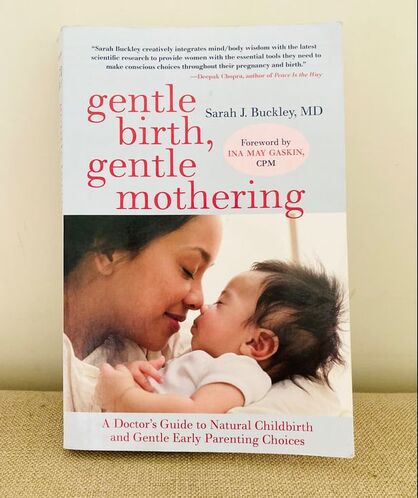 This post is part of a series of related posts: book reviews of the titles in my lending library. Click the link to read more! Ah, this book. It’s such a great read. Sarah Buckley, an Australian family physician, expertly walks the line between instinctive/super-crunchy/holistic and scholarly/super-well-researched/academic. It’s just brimming with quote-worthy snippets, so I’ve sprinkled them throughout this post for your reading pleasure. Enjoy! “Birth is women’s business; it is the business of our bodies. And our bodies are indeed wondrous, from our monthly cycles to the awesome power inherent in the act of giving birth. Yet in our culture I do not see respect for these extraordinary functions: instead we diet, exercise, abuse, conceal, and generally punish our bodies for not approximating an unobtainable ideal. This lack of trust in and care for our bodies can rob us of confidence in giving birth. Conversely, an experience of the phenomenal capacity of our birthing body can give us an enduring sense of our own power as women. Birth is the beginning of life; the beginning of mothering, and of fathering. We all deserve a good beginning.” The book begins with a few chapters on instinctive birth and trusting your inner self, and how healing birth can heal the earth. “We cannot birth our babies through sheer force of will. We need to learn the more subtle—yet equally powerful—path of surrender.” “In surrendering to birth, we also learn about our role on the Earth: we are neither the rulers nor the architects of creation. Life comes through us, simply and gracefully, when we allow it.” Buckley then gives a step-by-step guide to sound personal medical decision-making. She calls this the BRAN method, and encourages her readers to consider the Benefits, Risks, Alternatives, and possibility of doing Nothing when they are faced with a medical decision. She then applies this method to common pregnancy and birth procedures (Gestational Diabetes, Group B Strep, Going “Overdue”), outlining the research as she discusses each option. “If the baby is truly large, it is likely that the mother’s body will have maximum pelvic softness and flexibility (due to peak levels of hormones such as progesterone) on the day she spontaneously goes into labor, giving her the best chance to accommodate and birth her large baby.” In subsequent chapters, Buckley thoroughly reviews the research on common birth interventions, such as ultrasounds, epidurals, and cesareans. Each chapter has literally hundreds of footnotes—it’s clear that Dr. Buckley has done her homework! “On average the first stage of labor is twenty-six minutes longer in women who use an epidural, and the second (pushing) stage is fifteen minutes longer.” “The combination of epidurals and Pitocin, both of which can cause fetal heart rate (FHR) abnormalities and fetal distress (reflecting a critical lack of blood and oxygen), markedly increases the risks of operative delivery (forceps, vacuum, or cesarean delivery).” She also peruses the evidence on gentler birth and mothering choices. With great detail, she describes the beautiful hormonal cocktail that accompanies and enables undisturbed birth. “When birth is undisturbed, our birthing hormones can take us into ecstasy—outside (ec) our usual state (stasis)—so that we enter motherhood awakened and transformed.” “Birth is a peak bodily performance, for which our bodies are superbly designed.” She shows the safety and beauty of home birth for low-risk mothers; she tells the story of how love and attachment can be naturally and gently formed in the baby’s early days. “One study showed that newborns who experienced “kangaroo care”—that is, uninterrupted skin-to-skin contact with the mother—in the first hour after birth were less stressed and more organized in their behavior, cried less, and slept longer, compared with babies who were routinely separated.” She examines the vast research supporting breastfeeding and the many benefits it offers mom and baby, and she goes over the benefits of co-sleeping and how to safely practice it. I’d highly recommend getting your hands on a copy of Sarah Buckley’s Gentle Birth, Gentle Mothering. It will open your mind to new ways of thinking and fill your mind with evidence-based information. As I closed the book, I felt energized, empowered, and grateful for Buckley’s great contribution. “A recent review of satisfaction after childbirth found that personal expectations, support from caregivers, the caregiver-patient relationship, and involvement in decision-making are the most important factors in determining satisfaction with the experience of childbirth.” Have you read Gentle Birth, Gentle Mothering? I'd love to hear what you thought of it! 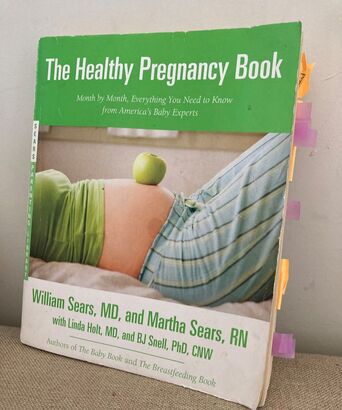 This post is part of a series of related posts: book reviews of the titles in my lending library. Click the link to read more! As you can tell from the sticky notes, this book is packed full of good information! I appreciate the Searses' well-rounded and positive approach to pregnancy they take in this book. They begin with detailed information about how to have a healthy pregnancy through wise nutritional choices, movement, sleep, and self-care skills. This starts the book off on a great foot for helping women be the responsible agent in their pregnancy and birth, which I believe is critical! They list helpful nutrients for pregnant women and their developing babies, the foods that offer them, and even recipes to incorporate them in your diet. In the section on exercise, they emphasize the importance of moving healthily and the wide range of activities that pregnant women can do to stay in shape and help their bodies and their babies be as healthy as possible. The next section of the book details the month-by-month changes that occur in the developing baby and the pregnant mother's body. They address concerns and discomforts that may arise by offering helpful tips and solutions. In the section on birth, they offer a detailed explanation of the "hormonal symphony of birth" and beautifully describe how mom and baby's bodies work together to bring baby into the world. They address common interventions and when they can be helpful and when they'd be better avoided. In the final section, uncommon pregnancy complications are addressed. The section begins with the directive to read only those sections that pertain to a complication you have, as there's no need to worry about things that could but likely won't--wise advice for an expectant parent! I especially appreciate their re-framing of the term "high-risk pregnancy." They explain that this term is necessary for doctors to be aware of women whose pregnancies and births should be monitored more closely, but invite women in this category to instead consider their pregnancy as "high responsibility": "Instead of resigning yourself to the high-risk label, becoming a passive patient, and leaving all birth decisions up to your doctors, become a high-responsibility mother. Take an even more active role in your birth partnership; cooperation between you and your care providers is essential. You need to be more informed and more involved in decision-making than the average mother, and you need to take better care of yourself. The first question you should ask your doctor after you are classified as high-risk is what specific things you can do to lower that risk." I especially appreciated this advice because both of my pregnancies have been "high-responsibility," the first because I was carrying twins, and the second because I have a blood-clotting disorder and was planning on a VBAC. In my first pregnancy, I resigned myself to the "high-risk" label and stopped asking many questions and taking personal responsibility for my pregnancy, and I ended up with some complications that I believe I could have avoided if I'd been a more active participant in my health care. In my second pregnancy, I made sure I was well-informed and the responsible agent for caring for my extra needs, and I had a very positive experience as an active birth-giver! In all, I definitely recommend this book as a comprehensive guide to having a healthy and positive pregnancy. It's the best book of its kind in that category!  Melissa Chappell, Utah County Midwife Melissa Chappell, Utah County Midwife This is the seventh post in a series of blog posts based on interviews I’m doing with midwives who serve Utah County. In this post, I’ll introduce you to the wonderful Melissa Chappell, owner of Songbird Maternity and co-owner of Utah Birth Suites, alongside Seasons Warner. She attends births at their beautiful new birth center in Provo, as well as home births in Utah County. Twenty-six years ago, when Melissa was pregnant with her first child, she took a Bradley Method birth class and had a great first birth experience, even though her labor was very long. After that birth, she wanted to teach others to help them prepare for awesome birth experiences, so she became a childbirth educator. Later, she became a doula, then a doula trainer, and then a midwife, which she has been doing since 2015! She attended The Community School of Midwifery and completed the North American Registry of Midwives (NARM) Portfolio Evaluation Process and earned her CPM and Utah State Licensure (LDEM) credentials in 2018. Now, she also enjoys teaching potential midwives! Over the 25 years she’s served the birth community, she has touched the lives of hundreds of birthing families. During our interview, I asked Melissa if she would talk with me about pushing, or the second stage of labor. If you’ve ever watched a TV birth scene, you likely imagine many people standing around, chanting, “Push! Push!” or counting from 1 to 10 as the mother bears down, purple-faced and out of breath. But, as Melissa can attest, birthing your baby doesn’t have to be this way! In fact, that’s not how it goes at all at the births that Melissa attends. “Most of the time, if you just let a mom follow her body, she’s going to be able to push on her own,” she says. Melissa mentions that some people say they’ve given birth to multiple babies and never really felt the urge to push. “A lot of times that comes from people not really being given the time for their bodies to get to that point where they’re ready to push,” Melissa explains. “I mean, no one’s just going to sit there with a baby inside them forever! Their bodies are eventually going to help them know how to push the babies out.” Sometimes, you may reach full dilation (10 cm), and still not feel, instinctually, that it’s time to push. Your contractions may even slow down for a while and give you a little break. When that happens, Melissa calls it the “rest and be thankful” stage. As you take some time for a little break before birthing your baby, your baby descends further into your pelvis, until you may notice that you’re grunting a little at the top of each contraction. When Melissa hears that little grunt, she gets excited—the baby is almost here! Once the second stage of labor (pushing phase) starts, the length of time until baby is born varies greatly. On average, Melissa’s clients push for under an hour, but some push for a couple of hours, and every now and then, up to four hours! Recent research indicates that this is safe as long as both the mother and her baby’s vital signs look good and she is making progress in moving the baby down. In a first birth, Melissa will sometimes offer gentle coaching or direction if her clients would like more guidance about how to push. One way she may do this is by gently placing her finger inside the bottom of the vagina (in the perineal space) to offer direction about where to push. Of course, Melissa never does this without the explicit consent or request of her clients! For many clients, though, Melissa doesn’t give any direction or coaching. She just gives them time and space to listen to their bodies. And what about cervical exams? Melissa says she rarely does them. (Although with first time moms, she does them a little more frequently, to help them assess where they are in their labor progression when they first arrive at the birth center.) “As a midwife, after doing this for years and years, you get to a point where you can tell without doing a cervical check, if someone is almost ready to push.” She listens to the sounds her clients are making (like that little grunt at the top of each contraction), and she watches the pattern of their labor: the length, frequency, and intensity of their contractions. By closely watching and listening, Melissa says that cervical exams to ensure complete dilation before pushing begins are rarely needed. Melissa further explains, “If you’re really, really empowering a laboring person to listen to their body and not push unless she feels that overwhelming urge, you’re not going to have people pushing on cervixes that are not ready to be pushed on.” Melissa is not alone in the way she empowers and encourages her clients to listen to their bodies and instinctively push during labor—there are many other fabulous midwives across Utah County who offer that same sort of care! I’m grateful that Melissa took the time to discuss this important topic with me, and for the individualized and empowering care she gives to her clients. She has a vibrant personality and lots of enthusiasm for the incredible work she does. Head on over to her website to learn more! This is the sixth post in a series of blog posts based on interviews I’m doing with midwives who serve Utah County.
Today’s post is based on a conversation with Amy Ihrig. Amy owns Joyful Birth Midwifery Services. She has been in the birth community for 15 years (starting out as a doula), and has been a midwife for about five years. She graduated from Midwives College of Utah and is a Certified Professional Midwife (CPM). Amy attends home births in northern Utah County. Amy is passionate about learning and teaching, and it shows with the wide ranges of classes and services she offers! In addition to being a midwife, Amy is also a Bradley Method Childbirth educator. The Bradley method focuses on how husbands can support their wives during labor and birth. She also teaches infant massage classes for new parents, as well as comfort measures classes, which she calls “doula dad” courses. And she teachers mother/daughter maturation classes using the Maidens by His Design curriculum, a Christian-based program to help mothers and daughters understand and communicate about their incredible bodies. As you can surely tell from that impressive list, Amy believes in the power of education and the wonder of birth. She truly believes that birth can and should be a joyful experience. Amy is a holistic care provider; rather than just considering her clients’ medical well-being, she looks at the whole picture of their overall wellness as part of her care. Like many midwives I’ve interviewed, Amy began her journey to midwifery as a doula. She decided to become a doula after her awesome second birth experience (an accidental home birth—keep reading for the details!) After nearly a decade as a doula, she felt called to expand her scope of practice to be able to provide fullness of care—medical and beyond—to her clients. Since I’ve noticed this doula-->midwife pattern in several conversations with midwives I’ve interviewed, and I’m currently riding the doula-->midwife trajectory after having a transformatively awesome birth, I joked with Amy that having an amazing birth is a “gateway drug” for aspiring birth professionals. Give a woman an amazing birth, and she’ll want to become a doula. When she becomes a doula, she’ll love it and realize the importance of education along the pregnancy and birth journey. She’ll decide to become a childbirth educator. When she becomes a childbirth educator, she’ll realize that she could expand her circle of influence even more by becoming a midwife. When she becomes a midwife, she’ll continue to seek opportunities for learning and growth to better serve her clients and invite them to have amazing births. And when her clients have amazing births… (Now that’s a version of If You Give a Mouse a Cookie, or, rather, If You Give a Woman an Amazing Birth that I can get behind! Give me that kind of ripple effect any day!) Back to Amy’s journey from amazing birth to doula to midwife. Before becoming a doula, Amy was staunchly opposed to home birth. Then, she had an accidental home birth. Her labor moved along much more rapidly than she expected, so she birthed her baby in her bedroom with baffled paramedics as her birth attendants. The birth was smooth and beautiful, and something in Amy shifted. Her next birth was a planned home birth, and the rest is history. Now, Amy is a strong proponent of home birth and the opportunity it affords for an intimate birthing experience. She loves supporting her clients as they make informed decisions in the peace of their own home. “My ideal client,” Amy says, “is someone who takes responsibility for their own choices. They will listen to the education that I’m providing them, and they will pursue further research in helping themselves to stay healthy and low-risk.” Having a joyful home birth is not a fictional fantasy. Amy’s passion and work is to make the dream of a joyful home birth a reality for her clients. Preparing for a home birth requires research and work, and a supportive and experienced midwife. We are lucky, here in Utah County, to have so many such options! And we’re fortunate that Amy Ihrig is among them. New Intermountain Hospital in Spanish Fork: A Tour in Pictures of the Labor and Delivery Wing4/6/2021 5/9/23 UPDATEBack in April 2021, when the new Spanish Fork Hospital opened its doors, I heard news of a plan to open a birth center in the adjacent Valley Women's Health clinic. I even toured the hospital and saw the birth center under construction (photos and description in the original blog post--scroll down). I was thrilled to hear the news, and so many of you were, too! Recently, I called to check in on the status of this birth center, and was told that the plans to open it were on hold, with no anticipation of moving forward. If this news is devastating to you, like it was to me, I have come up with a solution! I want the Valley Women's Health Spanish Fork clinic and the Spanish Fork Hospital to hear our voices! I have written form letters that you can personalize as little or as much as you'd like and send to the hospital CEO and the OB/GYN director at Valley Women's Health in Spanish Fork. If you want to make your voice heard, this is a quick way to do that! Hospitals and clinics are businesses, and we're their customers. They need to hear from us! Click the button below to access a Google Doc with the letters, download a copy, personalize, print, and send them in the mail! Please share this news and the form letters with anyone you know who may be interested in having a birth center adjacent to the Spanish Fork Hospital! Original Post: 4/6/2021The new Intermountain hospital in Spanish Fork opened yesterday (April 5, 2021), and let me tell you... they are doing things right for birthing families! I had the privilege of touring the hospital a couple of weeks ago, and I am just giddy with some of the features they included in their Women and Newborn wing. I'll highlight my favorites below. First of all, will you just take a look at this gorgeous tub?! There are six labor and delivery rooms in the new Spanish Fork, and three of them feature one of these beauties! The tubs have a variety of built-in stools and foot rests to enable a variety of labor positions in the tub. The hospital isn't currently set up for water births, but these tubs do drain quickly if baby is coming and you don't want to climb out of the tub. These fantastic tubs are the central features of the large labor and delivery rooms they are in, which also include a couch that folds out into a bed, a recliner, a bathroom with a shower, and plenty of room to walk/dance/squat/do whatever feels right! The hospital will also have wireless, waterproof contraction/fetal monitors to enable monitoring and movement simultaneously. After birthing your baby in one of these rooms, you'll then move down the hall to the other side of the unit to a postpartum room. There are twelve postpartum rooms, and they are attended by the same nurses who attend the labor and delivery rooms, enabling greater continuity of care throughout your stay at the hospital. As a special touch, each family will enjoy a celebration meal in their postpartum room, served at a decorated table on beautiful dishes. What a fun idea! For families who want to expedite their hospital stay, the Spanish Fork hospital also has one room for their Simply Birth program. Participants in this program do most of their postpartum education at home so that they can check out of the hospital faster after birth. The largest room at the end of the hallway in the Mother and Newborn unit is reserved for participants in the Simply Birth program, who will labor, give birth, and recover in the same room. Here it is: I can't wait to see all of these features put to use as I support clients birthing at this hospital! And........... In about two years, things will be even better! That's the projected timeline for the opening of the birth center that is adjacent to the hospital! This space is technically not part of the hospital, though the two buildings are connected. The birth center will be staffed by Certified Nurse Midwives who work at the Intermountain clinic alongside the hospital. The birth center is currently under construction, but I got to take a peek at it as well! There will be two birthing rooms at the birth center, which right now look something like this: Let's zoom in on some of my favorite features! Here's a close-up of the nice large tub in the birthing center, as well as ceiling attachments for a labor sling! Rather than a narrow hospital bed, these birth center rooms will feature a queen size bed with room for the whole family. The beds haven't been installed yet, but I took a picture of the wall where the bed will go so that you can fill it in with a queen size bed in your mind.
I love that this birth center will be right next to the hospital, to give families peace of mind in knowing that if a transfer to the hospital is needed (or desired), it's just a quick walk/roll down the hallway that connects the two fourth-floor facilities.
What questions do you have about the new birthing facilities in Spanish Fork? I'm not an expert, or an Intermountain employee, but I did ask a lot of questions on the tour! I'd be happy to chat more! I can't wait for families of Utah County to start enjoying these new facilities! I look forward to supporting many families as a doula in these awesome new spaces! This is the fifth post in a series of blog posts based on interviews I’m doing with midwives who serve Utah County and the surrounding areas. Today, I’m honored to introduce you to Katia L’Ecuyer. Katia owns Innate Midwifery with birth centers in Holladay and West Jordan, UT. She also attends home births in Salt Lake County and north Utah County. She is a Certified Professional Midwife (CPM), a Licensed Direct Entry Midwife (LDEM), and a graduate of Midwives College of Utah. She also holds a bachelor’s degree in biology with a minor in chemistry from Utah Valley University. As a midwife for over 10 years, she has attended over 500 births in both Utah and Costa Rica. Katia is also a midwifery preceptor and enjoys mentoring student midwives. During her time at UVU, Katia was the recipient of the Board of Trustees Scholarship in recognition of the research she has conducted on Group B Streptococcus during pregnancy. Even though she has graduated, she continues her research on Group B Strep with the aim of learning more about whether probiotics can be effective in preventing Group B Strep during pregnancy. Group B Strep (GBS) is a type of bacteria that lives in the intestines and can sometimes travel to the rectum, vagina, and urinary tract. Because this carries a possibility of leading to infection in the newborn baby if a mother has Group B Strep in her vagina at the time of birth, pregnant women are routinely tested near the end of their pregnancy to determine whether they are currently colonized by Group B Strep. Those who are, are termed “GBS positive,” and (in the U.S.), care providers typically recommend that they be given IV antibiotics during labor to kill the bacteria and prevent it from spreading to the baby during birth and possibly causing an infection. To learn more about the evidence on Group B Strep and its significance in pregnancy and birth, check out this article by Evidence Based Birth. Katia’s research on Group B Strep stems from a 2016 study conducted by Ho et al. In this study, researchers divided 110 GBS positive women in weeks 35-37 of pregnancy into two groups. To one group, they gave two placebo pills to be taken each night at bedtime. To the other group, they gave two probiotic pills (containing the probiotic strains L. rhamnosus GR-1 and L. reuteri RC-14) to swallow every night. They hypothesized that perhaps taking oral probiotics, which colonize the gut with “good” bacteria, would get rid of “bad” bacteria, like GBS. When these women gave birth about three weeks later, 43% of the women who had taken the probiotics were then GBS negative, whereas only 14% of the women in the placebo group were GBS negative at the time of birth. These results were significant enough for the researchers to conclude that taking L. rhamnosus GR-1 and L. reuteri RC-14 oral probiotics during pregnancy is helpful to reduce GBS colonization in pregnancy. This study was significant enough to attract the attention of researchers—like Katia—to dig deeper and get a better idea of what was going on with the use of probiotics to prevent or treat GBS, and whether the results could be generalized for all pregnant women. Subsequent researchers found, however, that the results of the 2016 Ho et al. study can’t be generalized to all populations. For instance, when researchers at Stanford University attempted to replicate the study, they did not find the same results. There are several shortcomings with the study that Katia is digging into and trying to overcome in her research. For instance, we know that it typically takes 30-60 days for oral probiotics to colonize the vaginal and rectal mucosa, but in the Ho et al. study, participants took the probiotics for just three weeks on average. Katia wonders if that oversight may be one reason the results haven’t been replicable. We also know that our gut microbiome is very influenced by our diet and lifestyle. Since the Ho et al. studied was conducted in Taiwan, it makes sense that its results may not be generalizable to pregnant women in the U.S., who have a very different diet and lifestyle. Katia’s goal is to further investigate these dietary and lifestyle differences and how they play out in the different bacteria that colonize our bodies during pregnancy, and which specific strains of probiotics would then prove most effective in preventing Group B Strep colonization during pregnancy. Research in these fields is time-intensive and not for the impatient. As Katia continues to chip away at cracking the GBS code, she spends daily energy to ensure that her midwifery clients are educated and informed decision-makers. On every topic, with every recommendation she offers, Katia makes sure to give her clients lots of information and point them in the direction of more.
“I have informed consent for everything,” Katia says. “I think it’s a big piece of why people choose midwifery care, is to not be dictated what to do, but to feel like they have a say in their care.” When emergencies come up and long conversation about the pros and cons of a choice aren’t possible, Katia relies on the relationship of trust she has built up with her clients throughout pregnancy. She’ll have as thorough a conversation with her clients as the situation allows. If a client’s birth isn’t going exactly as they’d hoped and they’re needing to make decisions they didn’t want to make to ensure the safety and health of themselves or their baby, giving them a chance to talk about it as much as possible makes a big difference. “The outcome, we can’t change. But how we feel about the outcome…” Katia believes that these conversations can make a big difference in those feelings. “Those conversations are really meaningful, because it does make the women feel like they were part of the decision-making process.” From my conversation with Katia, I could easily sense her expertise as a midwife and her trust in her clients to be the decision-makers in their pregnancy and birth journey. Whether she’s guiding her clients through the process of making a decision or continuing to research Group B Strep, Katia is thorough, professional, and compassionate in her work. 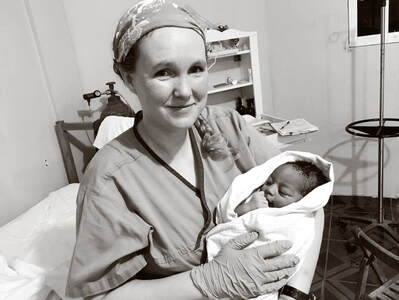 This is the fourth post in a series of blog posts based on interviews I’m doing with midwives who serve Utah County. This week, I’m spotlighting Seasons Warner (CPM, LDEM), owner of Four Seasons Midwifery. Seasons has been practicing as a midwife since 2014 and attends home births in the greater Utah County area (especially south of Utah county, extending into Juab, San Pete, and Sevier counties). Fun fact: if you see a car with a Utah license plate the reads MIDWIFE, you’re tailgating Seasons. So give her some space if it seems like she’s in a hurry to get to a birth! Alongside Melissa Chappell, Seasons also co-owns Utah Birth Suites: a beautiful birth center with locations in Orem and Provo. Both locations are beautifully and thoughtfully designed to give expectant families a feeling of homey comfort with all of the medical tools needed for pregnancy visits and birth. They’re also just minutes from local hospitals, in case a transfer of care is needed. I spoke with Seasons about the postpartum care she gives her clients. In the US medical model of maternity care, new mothers are typically discharged from the hospital 48 hours after giving birth and then not seen by their care provider until six weeks postpartum. This large gap in care, which comes after weekly prenatal visits at the end of the third trimester, can feel jarring and isolating to new parents who are physically recovering from giving birth and adjusting to caring for a (very sweet and cuddly but very needy!) newborn. Midwives, like Seasons, work to make sure that their clients continue to be monitored and well-cared for in the hours, days, and weeks shortly after birth. After Seasons’ clients give birth, she closely monitors them and their babies for a few hours to ensure that baby is eating and there are no pressing medical needs. Then, she packs up and leaves them to settle in as a family (if the birth was at home) or sends them on their way home (if they birthed at one of the Utah Birth Suites locations). Within 24-48 hours after the birth, Seasons visits her clients in their home (whether they birthed at home or at the birth center). Seasons again checks in with her clients via text every couple of days during the first two weeks after birth, and then they come to the birth center for appointments at two, four, and six weeks postpartum. This way, she’s regularly in touch with her clients as they recover from birth, and she’s able to offer ongoing newborn screenings and care. As a midwife, Seasons is licensed to offer well-baby care during the first six weeks of life. If any needs arise for mom or baby in the weeks after birth, Seasons is able to spot the need and care for it—or make recommendations for further care—before it becomes a larger issue. At her postpartum visits, Seasons offers standard postpartum care. She checks in on how breastfeeding and sleeping are going, bathroom needs, stitches and perineal healing, and cracked or sore nipples. She notes baby’s weight and growth, umbilical cord stump, and does a heart and lung check-up. She provides newborn metabolic screening (PKU) tests. After her check-ups, she’ll refer her clients to other medical care providers if anything looks abnormal. Another important service Seasons offers is repeated mental health screenings. Seasons asks her clients about how they’re feeling, who’s in their support system, and what their daily habits are. (Are they getting enough to eat and drink? Are they getting dressed, able to do some daily activities, and feeling like themselves?) This sort of screening is especially important at the four- and six-week postpartum visits, when lingering emotional or mental health concerns are an indication that her clients are in need of further care from a mental health professional. Throughout the days and weeks after birth, Seasons is always available through text or phone call if her clients have questions or needs along the way. She’s also well-connected with a local network of lactation consultants, pelvic floor physical therapists, chiropractors, pediatricians, obstetricians, mental health providers, and other specialists. Utah County has a village of postpartum care specialists, and Seasons connects her clients with the village when they have a specific need! As we concluded our conversation, Seasons reflected, “I think the thing that sets midwifery apart, really, in the postpartum period—not even just the frequency of our visits—is just the level of intimacy and care that you have with a midwife.” Those who are able to have this sort of connection and care with Seasons certainly count themselves blessed. This is the third post in a series of blog posts based on interviews I’m doing with midwives who serve Utah County.
For this post, I was honored to interview Amber Adams (DEM) and Teryl Stay (CPM, LDEM), who attend home births in northern Utah County and southern Salt Lake county. Together with student midwife Kirsten, Amber and Teryl are Birth Mind Body, midwifery care that “brings back the village” to care for new parents. Both Amber and Teryl attend all prenatal visits and births together and work as a team. Teryl and Amber each became midwives after first working as doulas. I loved talking with them about their journeys to midwifery, as my goal is to become a midwife as well! (I’m hoping to attend Vanderbilt’s CNM program. Fingers crossed!) Teryl became a doula at a friend’s suggestion and fell in love with community birth. She started attending Midwives College of Utah when her then-youngest child started kindergarten. For Amber, a series of random events led her to choosing midwifery care for her own first pregnancy and learning more about pregnancy and birth. After three people separately told her that she ought to be a midwife, Amber accepted the call to midwifery and also enrolled at Midwives College of Utah. Both Teryl and Amber had a baby (or two) while in midwifery school, and have personally experienced a range of birth experiences. They agree that the variety among their own births is an invaluable resource they drawn on as they support their clients. “I really believe that every midwifery journey gives you a different perspective to be able to help a client down the road,” Amber reflects. The main topic I chatted with Teryl and Amber about was how they support their clients through decision-making. Throughout the conversation, they both emphasized that they view their relationship with their clients as a partnership, and that they expect their clients to be involved, active participants in their care. Whenever their clients are making choices, their role is to teach their clients about benefits and risks of each of their options and respect their informed decisions as they move forward. Anytime screenings, tests, or interventions (such as glucose screening, Strep B testing, etc.) are offered, they provide an informed decision-making document with information about the possible benefits and risks of each option. Together with their clients, they talk through all of the information on the document and offer the chance to discuss any further questions they may have. The document also points them towards other resources they can consult as they make their own informed decisions. “A lot of it is based on trust,” Amber says. It’s important that their clients trust their midwives to give them the information they need to make decisions about their care, and that they trust themselves enough to confidently make decisions. Of course, there are times when, as medical care providers, Amber and Teryl sometimes need to hold firm on certain guidelines. They insist that all clients have an ultrasound to determine the placenta’s location during pregnancy, as placenta previa (when the placenta covers the cervix) is a serious complication that needs a higher level of care. If other complications arise during birth, trust is again key. Teryl explains, “It’s also so important to talk about this prenatally, and even during the interview, that these things can come up… We want to make sure that you have enough trust in us that if we’re telling you, ‘you need to go to the hospital; there’s a higher level of care needed,’ that they will trust us.” With this relationship of trust, Amber and Teryl strive to honor their client’s autonomy and provide safe, quality care throughout pregnancy, birth, and postpartum. |
AuthorHi, I'm Sara. I'm a childbirth educator and birth + postpartum doula serving Utah county. I'm a twin mom (plus one!), natural VBACer, and birth lover! Archives
February 2024
Categories
All
|






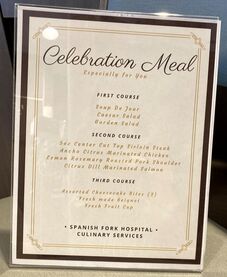








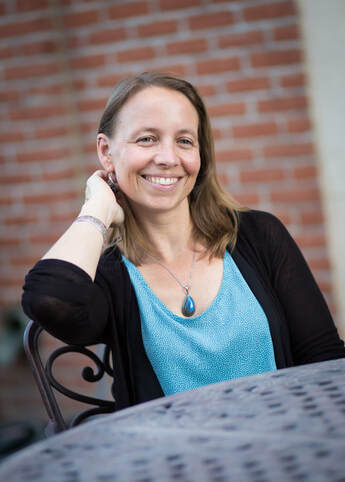





 RSS Feed
RSS Feed